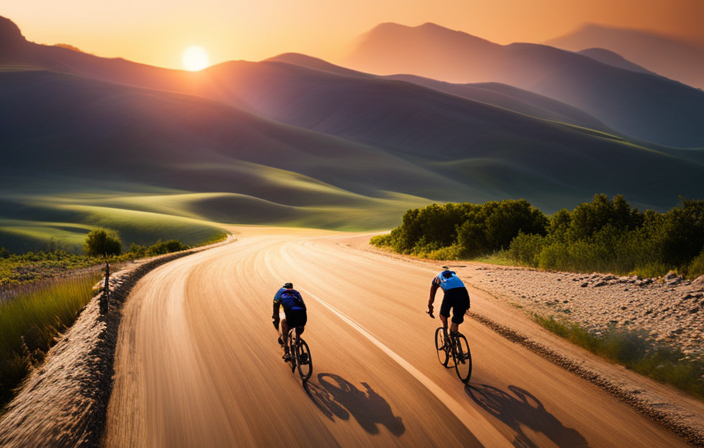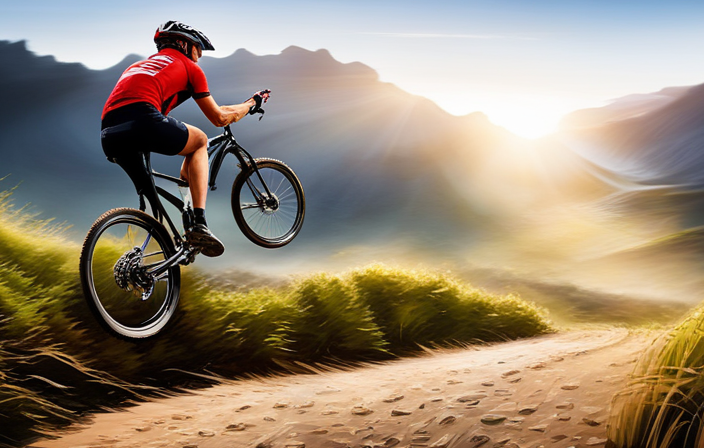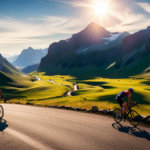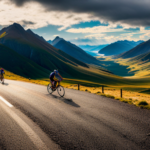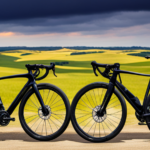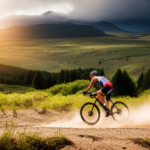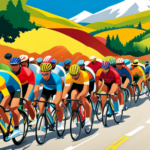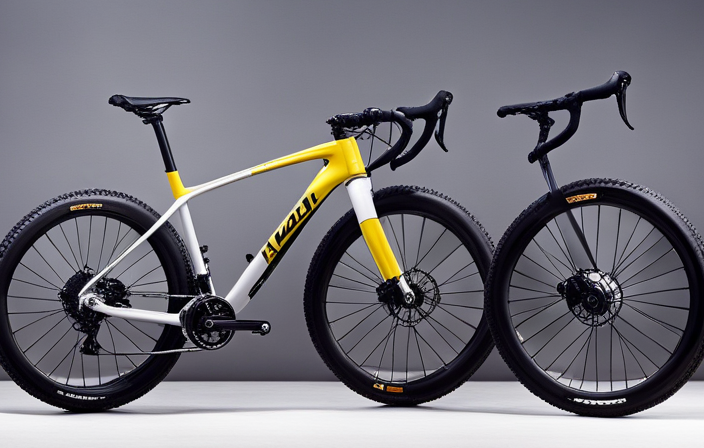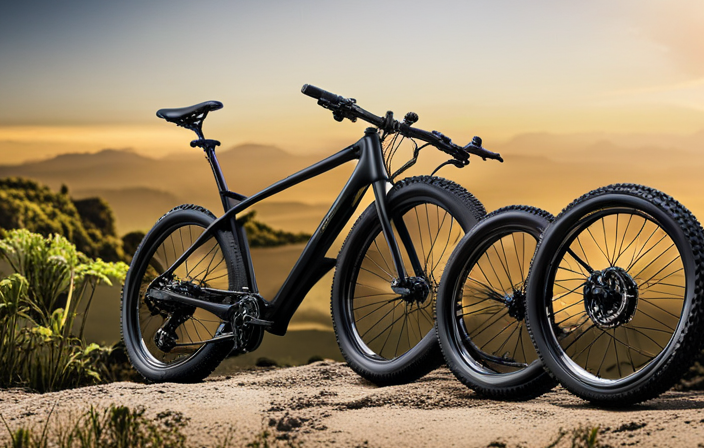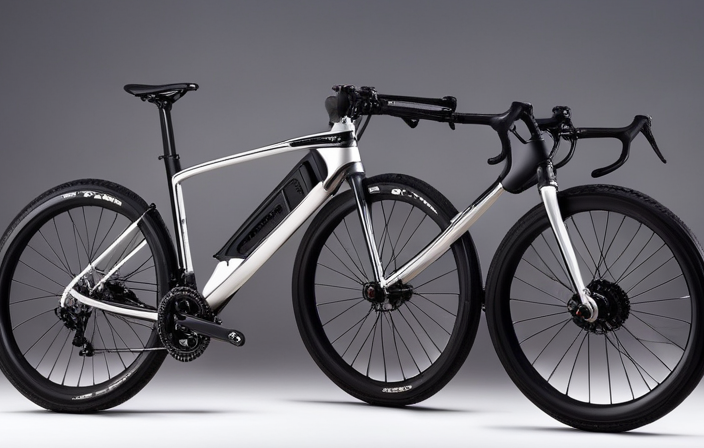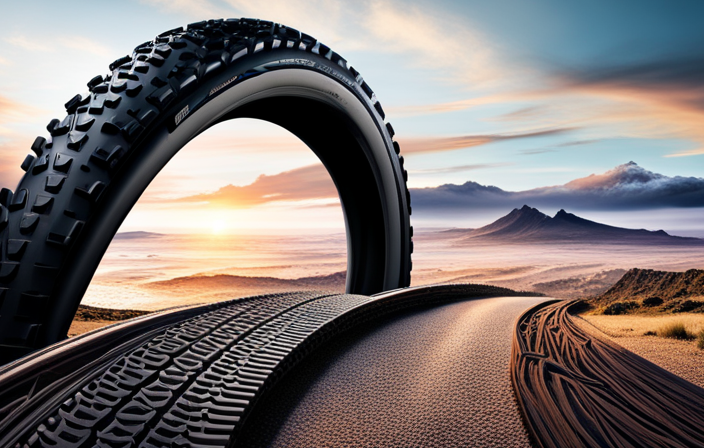Picture a beautiful sight of bicycles, their wheels turning together in perfect rhythm as they tackle the challenging Kansas countryside. This is the renowned Dirty Kanza 200, a gravel bike race that tests participants both physically and mentally.
With its rich history and challenging terrain, the Dirty Kanza 200 has become a bucket list event for cyclists around the world. Join me as we explore what makes this race so special, from its origins to training tips and reflections from those who have conquered it.
Get ready to embark on an unforgettable gravel adventure.
Key Takeaways
- The Dirty Kanza 200 is a grueling gravel bike race known for its challenging terrain and test of endurance and skill.
- Proper preparation and training, including training tips, essential gear and equipment, nutrition and hydration strategies, and bike maintenance, are crucial for success in the race.
- Mental preparation and strategies for overcoming challenges, safety and injury prevention, and race day tips and strategies are important for navigating the Dirty Kanza 200.
- The Dirty Kanza 200 has a significant impact on the local community, and features women riders who face unique challenges and have inspiring success stories.
History and Origins of the Dirty Kanza 200
So, you wanna know about the history and origins of the Dirty Kanza 200? Well, let me tell you all about it.
The Dirty Kanza 200 is a renowned gravel bike race that takes place in Emporia, Kansas. It has gained immense popularity over the years and has become one of the most challenging endurance races in the world.
The origins of this race can be traced back to 2006 when Jim Cummins and Joel Dyke organized a small group ride on gravel roads in the Flint Hills region. They wanted to create an event that would showcase the beauty and ruggedness of this area. Little did they know that it would eventually evolve into a major cycling event with participants from all around the globe.
The significance of Dirty Kanza lies in its ability to push cyclists to their limits both physically and mentally. It covers a distance of 200 miles through unforgiving terrain, including steep hills, rocky paths, and unpredictable weather conditions. Only those with exceptional stamina and determination can conquer this grueling challenge.
Now let’s move on to discussing the race route and terrain overview without missing a beat.
Race Route and Terrain Overview
Explore the challenging and diverse route of the Dirty Kanza 200, with its varying terrains and scenic landscapes. The race difficulty is no joke, as riders face a grueling 200-mile course through the Flint Hills region of Kansas. This area is known for its rolling hills, steep climbs, and unpredictable weather conditions. The route takes participants on a mix of gravel, dirt roads, and even some sections of pavement. Riders will encounter everything from loose gravel to mud pits, making it essential to have a reliable bike that can handle the demanding terrain.
One of the best training routes for preparing for the Dirty Kanza 200 is riding on gravel roads similar to those found in the race. This helps build endurance and adaptability to different surfaces. Additionally, incorporating hill repeats into your training regimen will help develop strength and stamina for tackling the challenging climbs during the event.
As we delve into training tips for the Dirty Kanza 200, it’s crucial to focus on building cardiovascular fitness while also practicing bike handling skills necessary for navigating rough terrain effectively.
Training Tips for the Dirty Kanza 200
When preparing for the Dirty Kanza 200, it’s important to focus on building cardiovascular fitness and honing bike handling skills. Here are three training tips to help you prepare for this grueling endurance event:
-
Long rides: To build your endurance, incorporate long rides into your training plan. Gradually increase the distance over time to simulate the demands of the race. Aim for at least one ride per week that is similar in length to the race itself.
-
Gravel-specific training: Since the Dirty Kanza 200 takes place on gravel roads, it’s essential to train on similar terrain. Seek out gravel routes in your area and include them in your training rides. This will help you become accustomed to the challenges of riding on loose surfaces.
-
Strength and cross-training: In addition to cycling, incorporate strength training exercises into your routine to improve overall power and stability. Focus on exercises that target your legs, core, and upper body. Cross-training activities like running or swimming can also help improve cardiorespiratory fitness.
By following these training tips, you’ll be better prepared for the physical demands of the Dirty Kanza 200. Now let’s move on to essential gear and equipment for the race…
Essential Gear and Equipment for the Race
To ensure a successful endurance event, you’ll need to have the necessary gear and equipment for the Dirty Kanza 200. Race preparation is key, and having the right gear can make all the difference in your performance.
One must-have piece of gear is a sturdy gravel bike that is specifically designed for off-road riding. It should be equipped with wider tires for better traction on rough terrain and a comfortable saddle for long hours in the saddle. Additionally, it’s important to have a helmet that fits properly and provides adequate protection.
In terms of must-have gear, a hydration pack or water bottles are essential to stay hydrated throughout the race. The Dirty Kanza 200 covers challenging distances, so it’s crucial to have enough water to keep you going. A good pair of cycling shoes with stiff soles will provide efficient power transfer and prevent discomfort during long rides. Don’t forget about appropriate clothing – moisture-wicking jerseys and padded shorts will keep you comfortable throughout the race.
Transitioning into the subsequent section about nutrition and hydration strategies for endurance events, fueling your body properly is vital for maintaining energy levels during such demanding races.
Nutrition and Hydration Strategies for Endurance Events
Make sure you fuel your body properly by following effective nutrition and hydration strategies for endurance events like the Dirty Kanza 200. Proper hydration is key to maintaining optimal performance and preventing dehydration during long races. It’s important to drink water regularly throughout the race, but also to replenish electrolytes lost through sweat. Fueling techniques are equally important, as they provide the energy needed to sustain your effort. Carbohydrates are crucial for endurance events, so consuming foods rich in carbs before and during the race can help maintain glycogen stores and delay fatigue.
To help you visualize a well-balanced nutrition and hydration plan, here’s a table outlining some strategies:
| Hydration Strategies | Fueling Techniques |
|---|---|
| Drink regularly | Consume carbohydrates from energy gels, bars, or sports drinks |
| Replenish electrolytes with sports drinks or electrolyte tablets | Eat small portions of easily digestible food like bananas or rice cakes |
By incorporating these strategies into your race day plan, you’ll be able to optimize your energy levels and reduce the risk of cramping or hitting that dreaded "wall." Remember that mental preparation plays a crucial role in overcoming challenges during endurance events. Stay tuned for tips on how to prepare mentally for the Dirty Kanza 200 gravel bike race.
Now let’s delve into mental preparation and strategies for overcoming challenges without writing ‘step’.
Mental Preparation and Strategies for Overcoming Challenges
Stay focused and mentally prepared to overcome any challenges you may encounter during the endurance event. Overcoming obstacles requires mental strength strategies that can help you push through difficult moments and keep moving forward.
One key strategy is to break down the race into smaller, manageable sections. Instead of focusing on the entire distance, concentrate on reaching the next aid station or completing a specific segment of the course. This approach helps to prevent overwhelming feelings and allows you to stay present in the moment.
Another useful technique is positive self-talk. During tough times, remind yourself of your capabilities and strengths. Encourage yourself with phrases like ‘I am strong’ or ‘I can do this.’ This kind of self-affirmation boosts confidence and motivates you to keep pushing through challenging moments.
Visualization is also an effective tool for mental preparation. Before the race, spend time imagining yourself successfully navigating different scenarios and overcoming obstacles. Visualize how you will handle unexpected challenges with calmness and determination.
Incorporating mental preparation into your training routine is crucial for building resilience during the race. Practice mindfulness exercises such as deep breathing or meditation to improve focus and reduce anxiety.
Transitioning into stories and interviews with previous race participants, their experiences provide valuable insights into different strategies for overcoming challenges during Dirty Kanza 200 gravel bike race without losing motivation or momentum while competing against other riders who are equally determined to succeed.
Stories and Interviews with Previous Race Participants
After diving into the mental preparation and strategies for overcoming challenges in the Dirty Kanza 200, it’s time to hear some stories and interviews from previous race participants. These firsthand accounts provide invaluable insight into the race day experience and offer valuable tips on how to tackle this grueling event.
One participant, Sarah, shared her experience of pushing through physical exhaustion by focusing on her training and reminding herself of all the hard work she had put in leading up to the race. Another rider, Mike, emphasized the importance of pacing oneself during the early stages of the race to conserve energy for later sections with more challenging terrain.
These participant experiences highlight just a few of the many strategies that riders employ during the Dirty Kanza 200. From nutrition plans to equipment choices, each rider has their own unique approach to tackling this demanding course.
Now that we’ve learned from these seasoned riders, it’s time to focus on safety and first aid tips for the Dirty Kanza 200 without compromising our performance on race day.
Safety and First Aid Tips for the Dirty Kanza 200
Now, let’s focus on some safety and first aid tips to ensure a smooth and secure experience during the Dirty Kanza 200.
When participating in such a challenging event, it is crucial to be prepared for any unforeseen circumstances. One of the most important aspects of safety is carrying essential first aid supplies. Make sure to have bandages, antiseptic ointment, adhesive tape, pain relievers, and blister treatment products in your pack. These items will come in handy if you or someone else encounters minor injuries along the way.
Emergency preparedness is another key factor to consider. It’s advisable to have a fully charged cell phone with emergency numbers saved in case you need assistance. Additionally, inform a friend or family member about your race plans and estimated time of completion. This way, they can alert authorities if you do not check-in within a reasonable time frame.
Remember to stay hydrated throughout the race and take breaks when needed. Dehydration can lead to dizziness and fatigue, increasing the risk of accidents. Pay attention to your body’s signals and don’t push yourself too hard.
With these safety measures in mind, you’ll be better equipped for an enjoyable Dirty Kanza 200 experience.
In the next section about the spectator guide: where to watch and support the riders, we’ll explore how friends and family can cheer on participants along their journey without interfering with their performance.
Spectator Guide: Where to Watch and Support the Riders
As a spectator, it’s important to know where you can watch and support the riders during the Dirty Kanza 200 gravel bike race. There are several prime locations along the course where you can catch all the action and cheer on your favorite cyclists.
Here are some watch locations and cheering strategies to make your experience even better:
-
Main Street Start/Finish Line: This is where all the excitement begins and ends. Get there early to secure a good spot and witness the start of the race as well as the intense finish.
-
Checkpoint #1 (Matfield Green): This is an ideal spot to see how the riders are doing after about 50 miles. You can grab a bite to eat at one of the local food vendors while waiting for them.
-
Checkpoint #2 (Cottonwood Falls): As riders approach this checkpoint around mile 100, you’ll have a chance to see them up close and personal. Make sure to bring signs or noisemakers to show your support!
By strategically planning your spectating spots and utilizing these cheering strategies, you’ll be able to fully immerse yourself in the energy of this thrilling event.
Now that we’ve covered where to watch and support the riders, let’s explore another aspect of the Dirty Kanza 200: its impact on the local community…
The Impact of the Dirty Kanza 200 on the Local Community
To fully understand the impact of the Dirty Kanza 200 on the local community, you’ll need to consider how it brings economic opportunities and boosts tourism in the area. The race attracts participants and spectators from all over, resulting in a significant boost to the local economy. Local businesses, such as hotels, restaurants, and shops, benefit greatly from increased patronage during the event. Additionally, many riders and their support teams spend money on accommodations, food, and supplies while preparing for the race.
The Dirty Kanza 200 also fosters community engagement by bringing people together to support the riders. Residents eagerly line the streets to cheer on participants as they pass through town. Local organizations often set up booths and activities along the route, creating a festive atmosphere that encourages community interaction. Volunteers play a crucial role in ensuring smooth operations throughout the event.
Furthermore, with its growing reputation as one of the premier gravel races in the world, the Dirty Kanza 200 has put Emporia on the map for gravel cycling enthusiasts. This has led to an increase in tourism year-round as cyclists flock to explore its scenic gravel roads even outside of race time.
With its positive impact on both economics and community engagement, it’s no wonder that women are increasingly drawn to participate in this challenging event.
Women in the Dirty Kanza 200: Challenges and Success Stories
If you’re a female cyclist, you may face unique challenges and find inspiring success stories when participating in the Dirty Kanza 200. This grueling gravel bike race presents both physical and mental obstacles for all participants, but women often encounter additional hurdles. Despite these challenges, many female cyclists have achieved remarkable success in the event, proving that determination and skill know no gender boundaries.
One of the main challenges faced by women in the Dirty Kanza 200 is the lack of representation. The race has historically been dominated by male participants, which can create an intimidating atmosphere for women looking to compete. Additionally, there are inherent physical differences between men and women that can pose additional difficulties during long-distance endurance events like this one.
However, despite these challenges, there have been numerous success stories of women who have conquered the Dirty Kanza 200. These athletes have not only finished the race but have also excelled in their performance. Their achievements serve as inspiration to other female cyclists who aspire to participate in this prestigious event.
Transitioning into tips for first-time participants in the Dirty Kanza 200: Now that we’ve explored the challenges faced by women in this demanding race and celebrated their triumphs, it’s time to offer some valuable advice for those embarking on their first Dirty Kanza journey.
Tips for First-Time Participants in the Dirty Kanza 200
For first-time participants in the Dirty Kanza 200, it’s essential to prioritize preparation and training to ensure a successful experience. As a first-time participant myself, I understand the challenges that come with tackling this demanding gravel bike race.
One of the biggest challenges is preparing both physically and mentally for the endurance required. To overcome this challenge, it is crucial to implement training techniques specifically designed for endurance. This could include gradually increasing your mileage each week, incorporating interval training to improve speed and power, and practicing long rides on similar terrain to simulate race conditions.
Additionally, nutrition plays a vital role in completing the Dirty Kanza 200 successfully. It’s important to fuel your body with proper nutrition before, during, and after the race to maintain energy levels and aid recovery. Experimenting with different types of fuel such as gels, bars, and electrolyte drinks during training rides will help determine what works best for you on race day.
Moreover, don’t underestimate the importance of bike maintenance. Regularly check your bike for any issues or wear that may arise from intense training or previous races. Ensure that all components are functioning properly, including brakes and gears.
In conclusion, being a first-time participant in the Dirty Kanza 200 can be daunting but with proper preparation through endurance-focused training techniques and attention to nutrition and bike maintenance, you can set yourself up for success in this challenging race.
Now let’s explore the evolution and growth of gravel bike racing without delay!
The Evolution and Growth of Gravel Bike Racing
As a first-time participant in the Dirty Kanza 200, I wanted to share some tips that could help you navigate this challenging gravel bike race. Now, let’s shift our focus to the evolution and growth of gravel bike racing.
Over the years, gravel bike racing has undergone significant evolutionary changes. What was once a niche sport has now gained immense popularity among cyclists of all levels. The appeal of riding on unpaved roads and exploring scenic routes has attracted more and more riders to take part in these races.
To understand the increasing popularity of gravel bike racing, let’s take a look at the following table:
| Evolutionary Changes | Increasing Popularity |
|---|---|
| Adventurous routes | Thrill-seeking cyclists |
| Improved technology | Wide range of participants |
| Supportive community | Unique experience |
These factors have contributed to the rise of gravel bike racing as an exciting and inclusive sport. It offers riders an opportunity to challenge themselves physically and mentally while experiencing breathtaking landscapes.
Now that we’ve explored the evolution and growth of gravel bike racing, let’s dive into why the Dirty Kanza 200 is considered a bucket list race for cyclists.
The Dirty Kanza 200: A Bucket List Race for Cyclists
Take on the ultimate challenge and add the Dirty Kanza 200 to your cycling bucket list. This 200-mile gravel bike race has become one of the most iconic and sought-after bucket list experiences for cyclists around the world. Known for its grueling terrain, unpredictable weather, and stunning views, the Dirty Kanza 200 offers a unique test of endurance and skill.
Preparing for this race requires months of intense training and dedication. Endurance training is essential to build up the stamina needed to tackle long hours in the saddle. It’s not just about physical fitness though; mental strength plays a crucial role as well. The ability to push through fatigue, discomfort, and doubt is what sets successful riders apart.
The Dirty Kanza 200 isn’t just a race; it’s an adventure that pushes you beyond your limits. From navigating treacherous gravel roads to battling extreme heat or unexpected rainstorms, every mile presents a new challenge. But with each challenge comes an incredible sense of accomplishment and a deeper connection with fellow riders who share in this extraordinary experience.
As I reflect on my own journey completing the Dirty Kanza 200, I learned valuable lessons about perseverance, resilience, and teamwork. Join me in exploring these reflections and lessons learned from completing this unforgettable race.
Reflections and Lessons Learned from Completing the Dirty Kanza 200
After completing the Dirty Kanza 200, I couldn’t help but reflect on the incredible experience and the lessons I learned along the way. This race truly pushed me to my limits and tested both my physical and mental endurance.
One of the most valuable lessons I took away from this grueling event is the importance of pacing oneself. With 200 miles of challenging gravel terrain ahead, it was crucial to find a sustainable rhythm and avoid burning out too early.
Another key lesson I learned was the significance of proper nutrition and hydration. The intense heat and demanding conditions made it essential to fuel my body with a balanced mix of carbohydrates, proteins, and electrolytes throughout the race. Neglecting this aspect would have had serious consequences for my performance.
Furthermore, completing such a demanding race taught me about perseverance and mental toughness. There were moments when doubt crept in, muscles screamed in pain, but pushing through those challenges ultimately led to an overwhelming sense of accomplishment.
Overall, participating in the Dirty Kanza 200 provided me with invaluable insights into my capabilities as a cyclist. It taught me about strategic planning, self-care during endurance events, and above all else, it showed me that with determination and preparation, no challenge is insurmountable.
Frequently Asked Questions
How do I register for the Dirty Kanza 200?
To register for the Dirty Kanza 200, follow these steps.
First, visit the official website and locate the registration page. Fill out the required information, including your personal details and emergency contact information.
Next, choose your race category and pay the registration fee securely online. The race fees vary depending on when you register, so be sure to check the website for current pricing.
Once registered, you’ll receive a confirmation email with further instructions for race day preparations.
Are there any age restrictions for participating in the race?
Age restrictions for participating in the Dirty Kanza 200 are an important aspect of the registration process. While this race welcomes participants of all ages, it is essential to note that individuals under the age of 18 must have a parent or guardian sign their registration form.
This requirement ensures the safety and well-being of younger participants, while still allowing them to experience the thrill and challenge of this renowned gravel bike race.
Can I use a mountain bike for the Dirty Kanza 200?
Yes, you can use a mountain bike for the Dirty Kanza 200. However, there are some limitations. The race is known for its challenging gravel terrain and long distance. Therefore, a mountain bike may not be the most ideal choice. A gravel bike is recommended due to its specific design for endurance on mixed surfaces. However, if you’re comfortable with the limitations of a mountain bike on this type of course, it is allowed for participation in the race.
Is there a time limit to complete the race?
Yes, there is a time limit to complete the race. The Dirty Kanza 200 requires participants to finish within 20 hours.
This adds an exciting element of challenge and pushes riders to their limits. It’s not just about completing the distance, but doing so within the set time frame.
Meeting this completion requirement demands physical strength, mental endurance, and strategic planning throughout the race.
Are there any specific rules or regulations participants need to follow during the race?
Participants in the Dirty Kanza 200 gravel bike race must adhere to certain rules and regulations.
Firstly, all participants are required to have a support crew or be part of a team.
Additionally, they must carry specific race equipment such as spare tires and tubes, a hydration system, and food for the duration of the event.
Riders are also required to wear helmets at all times during the race.
These guidelines ensure the safety and well-being of all participants throughout the challenging course.
Conclusion
In conclusion, after completing the Dirty Kanza 200, I can confidently say that it is a race like no other.
The challenging terrain and unpredictable weather make it a true test of endurance and grit.
But beyond the physical aspect, this race also offers a sense of camaraderie and an opportunity to push your limits.
As I reflect on my experience, I realize that participating in the Dirty Kanza 200 has taught me valuable lessons about perseverance and determination.
It truly is a bucket list race for any cyclist looking for a unique and unforgettable challenge.
So don’t hesitate to join the gravel racing revolution and take on the Dirty Kanza 200!
